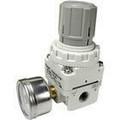You wouldn't ever want to install a positive pressure compressed air-driven system without some way to regulate it. Why, then, would you ever want to do the same thing with a vacuum-based system? The answer, of course, is that you would never want to do such a thing. That is why pneumatic vacuum regulators are a necessity.
No matter which direction that air is flowing in, you'll want to rig up some way to monitor and control its passage. That's important for safety reasons as well as efficiency-related ones.
Vacuum regulator products offer a variety of options including compact and lightweight design, and front or rear mounting of the vacuum pressure gauge. These vacuum regulators also offer standard panel mounting capability, adjustment resolution within 0.13kPa, and 1/8" to 1/2" threaded connection port sizes available.
Vacuum regulators come in almost every variety that you might expect to see other types of pneumatic regulation modules in. That means you'll have quite a broad choice when the time comes to pick out an individual module for your existing vacuum system.
Vacuum Generators For Commercial Operators
Whenever you select pneumatic components, you'll want to make a list of requirements. It doesn't matter which direction the air is flowing in for this process either. Once you find vacuum-driven components, you'll need to mark those as areas of potential need for vacuum regulators.
Engineers have often run into the issue of needing a module that doesn't take up a large amount of header space. That's especially true when it comes to installing pneumatic gear in any kind of case or other type of housing. This sort of arrangement is quite common in the manufacturing world, especially when it comes time to separate workpieces from the equipment itself.
If that's a concern of yours, then you'll certainly want to look into the ITV series of compact electro-pneumatic regulators. All ITV pieces are based on parts that are IP65 equivalent. Companies that have to maintain adherence to certain standards or, alternatively, need to keep them for their own purposes will be able to hold onto these.
Managers can have these installed at regular intervals so that they can be sure that the level of vacuum stays constant at all times. Users can rely on these modules to control air and vacuum pressure without stepping. Your level of control is genuinely analogous to these cases.
Digital control modules generally work along with a sort of ladder. When you change positions, you don't have any options between individual steps along the ladder. These modules instead work in proportion to an electrical signal. That's quite useful for anyone who finds themselves having to regularly adjust the amount of vacuum force being applied to an air circuit and wants to have more control over the process than usual.
All you have to do is simply twist a dial or adjust a single setting in order to maintain the desired level. This gives you a great deal of fine-tuning control that you wouldn't otherwise have with other comparable systems.
On top of this, they're light on weight and come with bright easy to read LED display screens. This enables you to monitor output at will. All you have to do is watch a single screen. It's as easy as glancing at a clock or any other one of the countless display terminals that you doubtlessly take a look at occasionally in our increasingly technology-driven world.
The device is either provided as analog or switched in terms of output. Best of all, it's easy to install IRV parts because of the convenient IRV 10/20 mounting bracket. These brackets easily assemble on top of all IRV 10/20 series components, which helps to ensure that they don't ever move out of place when you don't want them to.
Those who might want to work with ITV2000 series components can even go so far as to get a regulator kit, which will come with all of the components that they need to get the job done without having to wait around for any additional parts at a later date. That should help make the installation process even faster, especially for beleaguered companies that need to be up and running fast.
Mounting Parts For Vacuum Generators
In many cases, people have had to come up with unusual methods of installing a vacuum regulator so that it doesn't shift position when pressure is applied to your air circuit. This isn't exactly done to spec, and therefore it may be looked at as unsafe.
Fortunately, this system completely alleviates that problem by giving you a component with which to properly affix your vacuum regulator in position. Over time, you shouldn't notice too much deviation. Depending on the temperature, humidity, and pressure of the circuit that you're working with you might not notice any measurable level of motion beyond what would be considered a normal tolerance.
Even if you do have to make adjustments in the future, your equipment will be easy to maintain if it's been installed correctly. All you have to do is periodically check your vacuum regulator like you would any other piece of pneumatic equipment.
It's genuinely that simple, which should be good news for small business owners who have to do all of their own maintenance work and therefore can't dedicate too much time to each individual project. If you want to stay safe at all times, then you'll want to make sure that all of your pieces are connected properly.
Vacuum Regulators For Safety
Some engineers might look at vacuum generators as a way to provide a certain level of safety in the first place. They ensure that your vacuum force levels don't go too far out of specifications in either direction. While you might think of too much force as dangerous in many circumstances, too little can also be a serious problem since it could prevent certain motions from occurring at the times that they're supposed to.



